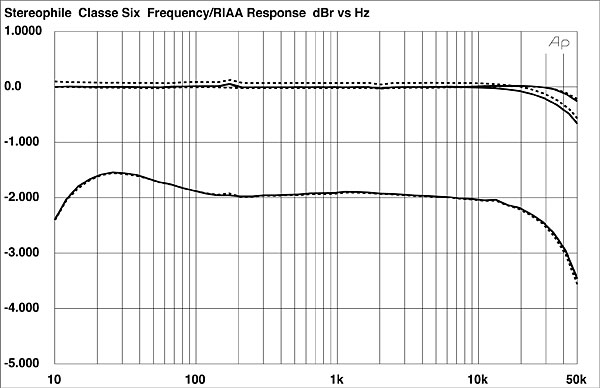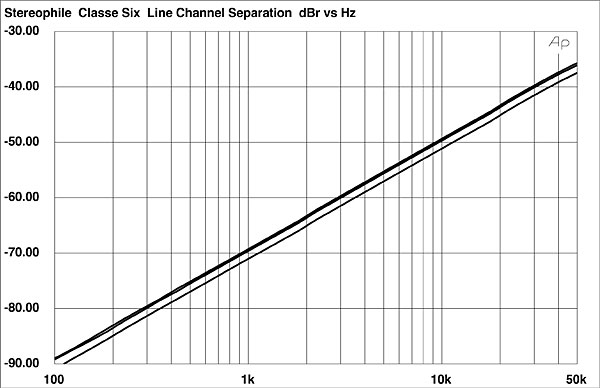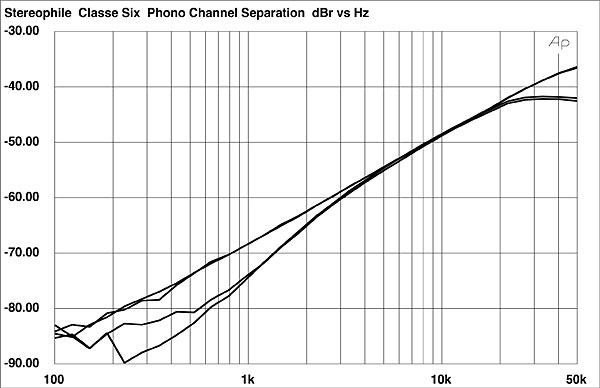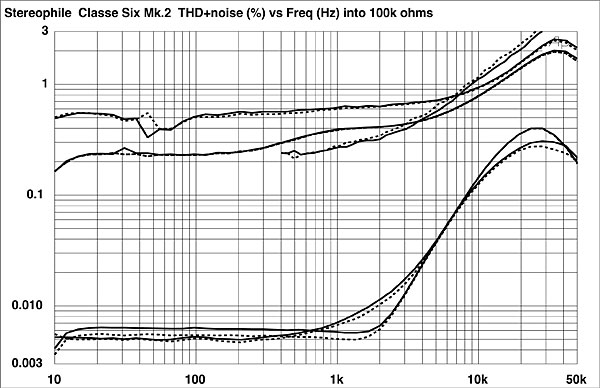| Columns Retired Columns & Blogs |
And now Classe Audio is dead.
All measurements were made in the normal (non-bypass) mode. Spot checks made in the bypass mode indicated virtually no measurable differences, with the exception of 0.02% lower THD+noise in the moving-coil phono mode at 1kHz—an insignificant change relative to the total reading.
The output impedance of the Classé 6 at its line output, measured at 1kHz, was just over 50 ohms, unbalanced (just over 100 ohms balanced). This is higher than the specified 1 ohm, but is still very good, and not atypical of solid-state preamps.
The (line) input impedance at 1kHz measured just over 35k/36k ohms (L/R), unbalanced (just over 200k ohms balanced). The output impedance at the tape output was approximately 3 ohms, a clear indication of a buffered output since the source impedance was 25 ohms. The Classé's MM phono input impedance measured 46.1k ohms at 1kHz. While the MC input impedance measured 33.6 ohms—a not unreasonable value—this figure is affected by the variable input impedance of the Classé 6's MC input. That is, the circuit interacts with the source impedance of the input device—normally an MC phono cartridge, but in this case the source impedance of our Audio Precision System One test set—to give an appropriate match.
We measure the input impedance of a device by recording the output voltage using a 25 ohm source impedance from Audio Precision, then change the latter to 600 ohms and, without changing the input voltage, measure the change in the output of the device under test. A BASIC computer program written by John Atkinson then calculates the input impedance reading from this change. But if the input impedance of the latter changes in response to the source impedance, this test will not yield an accurate reading.
The DC offset at the Classé 6's outputs measured under 1mV, balanced or unbalanced, though it fluctuated enough to indicate that this very low-level reading was affected by noise. The preamp is non-inverting from its line inputs to its main outputs; the phono stage is similarly non-inverting. The Classé's balanced-mode polarity in pin 2 is positive, in pin 3 negative. Line-stage gain (aux input to line output) measured to spec: 18.2dB for balanced, marginally higher at 18.3dB for unbalanced. Line-stage unity gain was reached at just below the 12 o'clock position on the level control. Phono-stage gain (taken, as usual, from input to tape output) measured 33.7dB (MM) and 55.5dB (MC). The latter is user-adjustable but was taken in the factory-standard position, which yields 22dB of gain above that for MM.
The Classé 6's frequency response is shown in fig.1. The two most linear pairs of curves at the top, displaced upward for clarity, are for the line stage. The flattest, topmost curves were taken at unity gain; the curves showing a slight rolloff beginning above 10kHz were taken at the maximum setting of the level control. The measurements shown in fig.1 were taken in the unbalanced mode; virtually identical results (not shown) were obtained in the balanced configuration. The tracking of the level control was excellent, with a maximum interchannel deviation of 0.2dB at the 3 o'clock setting. The RIAA response of the phono stage is also shown in fig.1 (bottom curve). The slight rise in the low bass, combined with the slight drop in the treble, suggests a slight warmth and softening of the sound in phono playback, though I would expect any such audible deviation to be quite subtle. In any case, the response is still within ±0.3dB from 20Hz–20kHz, and the responses of the two channels are virtually identical.

The line-stage crosstalk of the Classé 6 is shown in fig.2. The balanced crosstalk is actually slightly higher than the unbalanced, though the difference is not significant. Note that the crosstalk between channels in either mode is identical in both directions—the curves overlay each other and cannot be seen as separate traces on the graph. While this crosstalk result is not the best we've seen, it is more than sufficient for a secure stereo performance. In both cases we see the crosstalk increase (separation decrease) at high frequencies, which is typically caused by capacitive coupling between channels. Fig.3, the phono crosstalk for both the moving-magnet (low-gain) and moving-coil (high-gain) modes, appears to be quite similar to the line crosstalk in magnitude, with the results for MM and MC very comparable.


The line THD+noise vs frequency for the Classé 6 is shown in fig.4. The two overlaid curves at the bottom are for the line stages, both balanced and unbalanced. While the minimum 1kHz distortion for balanced operation was obtained with an input of 300mV, and 190mV (at lower input levels, low-level noise became a significant factor) for unbalanced, 300mV was used as an input for both these curves, to permit a more direct comparison. (This was only practical because the unbalanced, 1kHz THD+noise reading increased by no more than 0.001% with an input change from 190mV to 300mV.) The distortion is very low up to 1–2kHz, above which it shows a pronounced increase, though never to unacceptable levels.

The THD+noise curves for the phono stages are shown at the top of fig.4. An input of 2mV was used for the MM input and 4mV for the MC. Again, both were the levels below which noise became dominant in the measurement. Both phono distortion curves are noticeably higher than the best we have measured recently—though in admittedly much more expensive preamps. The moving-coil THD+noise, in particular, was likely influenced by the high input level used to minimize the effect of noise on the result.
In order to test this, I also measured the THD+noise for the MC stage with a 400Hz high-pass filter in the circuit. The result is shown in the fig.4 curve which begins at 400Hz and is located just above the MM curve. This curve was taken at an input of 1.5mV—the lower value in this case was possible because noise was less of a factor. While for this reason it isn't directly comparable to the full-range MC curve, it does indicate that the actual THD, divorced from the noise, is lower in level as we reach input values closer to those of actual MC cartridges. It's therefore more representative of the distortion likely to be experienced under normal use. (The increase in HF distortion above 8kHz visible in this curve is likely due to the increased contribution of HF noise at this lower input level.)
The Classé 6 would accept an unbalanced signal level of 1.095V at its aux (CD) input before reaching 1% THD+noise (with an output of 8.9V). In balanced mode, the same distortion level was reached at an input of 2.2V (17.9V out).
The MM phono overload values—again for 1% THD+noise—were 13mV at 1kHz, 33mV at 20kHz, and 2.3mV at 20Hz, equivalent to overload margins of 8.3dB, $*–3.6dB, and 13.25dB, respectively. (The differences in overload voltages at different frequencies are due to the characteristics of the RIAA curve.) These are low—ie, below average—values, but I also observed on the 'scope that the onset of visible waveform clipping in MM mode was fairly slow—occurring between 40 and 50mV input at 1kHz, at 170mV at 20kHz, and at 5mV at 20Hz—resulting in an effective overload margin far better than the standardized 1% THD+noise levels would indicate.
The 1% THD+noise level for an MC input was reached at 8.8mV at 1kHz, 25mV at 20kHz, and 1.4mV at 20Hz, equivalent to overload margins of 24.9dB, 14.0dB, and 28.9dB, respectively. (The MC 20kHz overload reading was taken with a 400Hz high-pass filter, which reduced LF noise and noticeably improved the result.)
Other than the questionable MM overload characteristics, the measured performance of the Classé 6 was very good across the board. Although it measured somewhat below the best we've measured (most often in more expensive products) in a few areas, nothing here would indicate less than a fine sonic result.—Thomas J. Norton

I see them alive and kicking. https://classeaudio.com/

I see them alive and kicking
See this report on an audio business site: www.strata-gee.com/classe-closing-october-6th/
John Atkinson
Editor, Stereophile

This is most disturbing. Thank you for the link.

I can remeber reading this article way back in 1994- miss you LG.